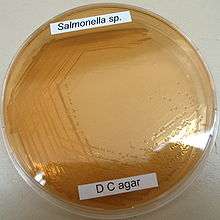DCA agar

DCA agar - Deoxycholate Citrate Agar is a solid bacteriological growth medium.
Uses
It is particularly useful for the isolation of organisms that cause bacilliary dysentery, salmonella strains that cause food poisoning and Salmonella Paratyphi. It is not so selective for Salmonella Typhi. This growth medium is inhibitory to most gut bacteria, in particular species of the genus Proteus, although these species do survive on DCA agar. It is therefore essential that suspected pathogens must be subcultured on a less inhibitory medium prior to identification. Salmonella spp appear to be yellow or colourless colonies, often with a dark centre. As there are many bacteria that also look like Salmonella on DCA, it is widely recommended that more selective agars are used for the identification of Salmonella, namely xylose lysine deoxycholate (XLD) agar. This growth medium is heat-sensitive and should be poured and cooled as soon as possible after addition of the deoxycholate, otherwise it tends to become very soft and difficult to handle. It has a pH of approximately 7.3, and when poured and cooled, appears light to dark pink in colour.
Contents
DCA agar contains:
| 'Lab Lemco' powder | 5g/l |
| Peptone | 5g/l |
| Lactose | 10g/l |
| Sodium citrate | 8.5g/l |
| Sodium thiosulfate | 5.4g/l |
| Ferric citrate | 1g/l |
| Sodium deoxycholate | 5g/l |
| Neutral red | 20 mg/l |
| Agar | 12g/l |